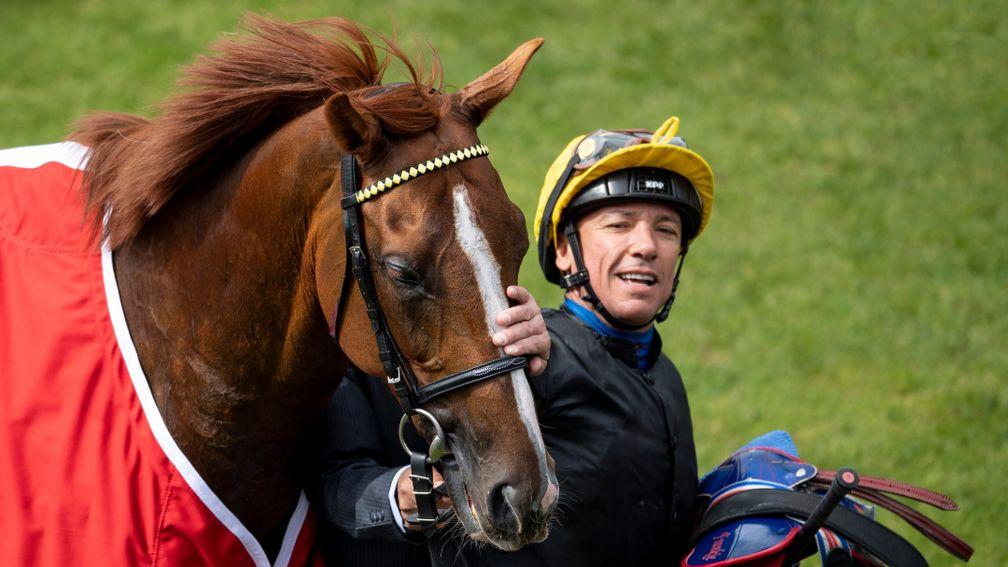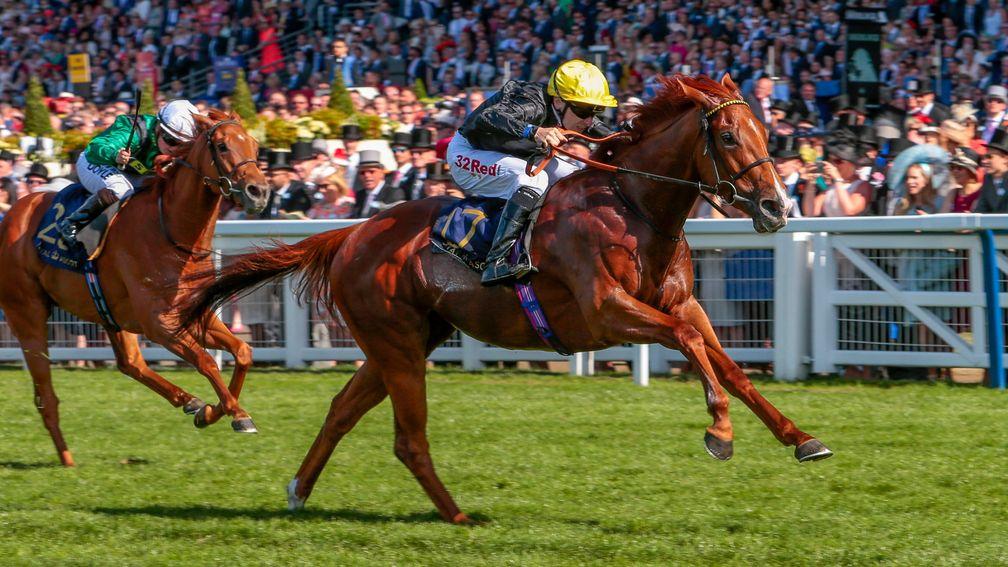Breeder Bjorn Nielsen staying the distance with mighty Stradivarius
Record fourth Goodwood Cup on the agenda for the six-year-old

Bjorn Nielsen has been around long enough to understand racing’s commercial realities, which goes a fair way towards explaining why we have Stradivarius to enjoy for another year.
While it would have been permissible for the breeder of the paragon of stayers to have arranged a stud deal, a likely combination of Nielsen’s pragmatism, benevolence and personal satisfaction means that such a decision can wait.
The marketeers gain with another big-race vehicle for Frankie Dettori, while history could mark a first four-time Goodwood Cup winner in more than 200 years. Indeed, perhaps the only loser will be Weatherbys Hamilton, or its insurers, who could face him landing a third straight £1 million bonus.
"When you’ve got a really good three-year-old that’s won the Eclipse and the Juddmonte, something like that, there’s pressure to retire them because if they run again at four and then they start getting beaten, people start saying they’re maybe not as good as we thought," he says.
"That’s why horses at three basically get retired because there’s no upside, there’s only downside. With him, there isn’t tremendous demand because he’s a stayer. As we’ve seen, everybody keeps talking about Crystal Ocean and how disappointing it was to see a horse like that cover jumping mares, and he probably falls in the same bracket at the moment."
Carrying on the theme, but with his tongue gently sinking into his cheek, he adds: "Maybe I have to talk John Gosden into bringing him back to the Eclipse or the July Cup to really make him."
In reality, it will be the tried-and-tested route. The chestnut, who has lost just once in two seasons when pipped by Kew Gardens at Ascot on Champions Day, is currently in light winter exercise.
"Campaign-wise, all being well, it’ll be the Sagaro or the Yorkshire Cup, that’s what John’s plan is," says Nielsen. "Then the Gold Cup is the aim and thereafter, if things go well, he’ll most likely go to the Goodwood Cup. That’s what we’re intending to do, and hopefully he’s on the same sort of form as he’s been the last couple of years."

It is, of course, people like Nielsen who could help Stradivarius become a stallion. As a child in South Africa, he became captivated by Sea Cottage, a legend of the 1960s who was once shot at to prevent him winning the Durban July, and would assiduously follow his progress via newspapers and radio.
Later, when growing up in Epsom, he watched with fascination early one morning when Vincent O’Brien and Lester Piggott road-tested a Derby contender, and he became equally obsessed with the race.
A career in hedge funds allowed him to start buying horses such as the classy Assessor in the 1990s and he has bred them with that same regard for middle-distance tradition over the fast and the fashionable.
"Montjeu was out of a mare who was second in the Prix Royal-Oak, by Sadler’s Wells," he says. "He was entitled to stay two and a half miles with his pedigree and he’s been one of the best stallions we’ve seen in 50 years – he’s had four Derby winners. So you never know.
"This horse does have that big turn of foot that very few horses have and mentally he’s so relaxed at the races, in his races, and if you pass that on, you’re going to have a good horse.
"If he had the opportunity to cover the sort of mares that would give him a chance to see what he is, you never know. There are probably many stallions out there that could have been top stallions but are never given the chance. Getting a good book of mares is a huge part of the battle."
Although Nielsen finds himself as one of the keepers of the staying flame, he explains it is not a selfish pursuit.
"The whole thing is, actually, the general public like it," he says. "They like it better than watching a sprint, it’s obvious when you go to the races, people are looking at the big staying events. It’s a big draw, especially when a horse gets a bit of a reputation and becomes a crowd favourite.
"It’s very important for places like England, and Germany and France to a certain extent. A lot of other racing jurisdictions have lost all their staying blood, we’ve still got a fair amount and it’s important to keep and promote it. They’ve been doing this for the last couple of years, with the BHA and prize-money levels. It will keep people breeding horses that stay some kind of trip."
There is one more reason why the champion has been allowed to sustain his longevity; while manufacturing another Stradivarius would be an onerous task in any event, Nielsen lacked even the raw materials.
Stradivarius's dam, the former Wildenstein mare Private Life, died not long after producing her son of Sea The Stars and had never furnished her owner with a filly.
It was only a year ago that Nielsen finally tracked down another remnant of a dynasty which also includes Melbourne Cup winner Protectionist.
"I have a half-sister to his dam, Parade Militaire, so I have something of the family," he explains.
"Jeremy Brummitt [his adviser] saw her in the catalogue at Keeneland, she had been bought by Peter Brant’s White Birch for €270,000 a couple of years earlier and was in foal to Mastery.
"She had a colt, and went to Sea The Stars – it was a pretty obvious cover. Let’s see if lightning can strike again some day."
He continues: "It’s a very good French family, it’s the family of Pawneese and Peintre Celebre, and Stradivarius is very well bred.
"It would be nice to keep the line going as I think it’s important for racing that some of these staying lines are around because the more people who breed speed to speed, they’re going to wind up with nothing in the end, because they’ll have to run shorter and shorter, or they run shorter but they run slower because they don’t get the trip."
High hopes for Ascot queen and English King
Bjorn Nielsen now has around 16 mares, the vast majority of which are managed by Simon Marsh at Watership Down and Kiltinan Castle Studs, and his band has been supplemented by Agrotera, who landed a hefty gamble in the 2018 Sandringham at Royal Ascot.
"Quite a few are from the My Branch family, along with a few others," he says. "They’re nice mares and I sell quite a few yearlings out of them to cover expenses, it’s an expensive game.
"Agrotera was unlucky, she got injured last year and we always felt she was a lot better than she’d shown. She’s going to Camelot, who is hopefully a good cover. She was a miler, a big, strong mare, and he’s a quality mile-and-a-half horse."
Given his thorough knowledge of breeding, it is no surprise to learn that Nielsen works out all his own mating plans.

"That’s what I like to do. I’ll ask advice from people who know more than I do about whether they disagree on certain things, typically from a conformation angle, because I’m doing it all on paper. I know my families, I know what the stallions look like, I know what my mares look like, I know what they produce, but they might say 'I wouldn’t necessarily do that', so I think about it."
The dream of winning the Derby persists, albeit not with a homebred this time around. The Ed Walker-trained English King, another Classically bred Camelot bought from Ecurie des Monceaux, looked a bright prospect in winning at Newcastle in late November.
"He seems a nice horse and we’ll see in the spring if he’s good enough for a trial of sorts," Nielsen says. "It’s too early to tell but he did win well at Newcastle. He’d be my most exciting three-year-old."
More news...
Issue of increased inbreeding 'akin to global warming' claims new study
Q&A: Professor Emmeline Hill tells us more about her inbreeding study
Meet Coolmore's new stallions Calyx, Magna Grecia and Ten Sovereigns
Published on 26 January 2020inFeatures
Last updated 17:42, 31 January 2020
- Oh, Gino took the stage all right but Walk In The Park and Authorized stole their share of Aintree limelight
- 'You sometimes forget they're stallions' - meet up-and-coming eventing stars Galileo Dance and Galileo's Secret
- 'Two decades in the bloodstock business has taught me more about people than horses' - meet Tattersalls rep Gaurav Rampal
- How pouncing on a 3,000gns broodmare helped Chris Liesack breed exciting Cuban Tiger
- Captain Cody keeping the spark alive for Waterford breeder Richard Morrissey
- Oh, Gino took the stage all right but Walk In The Park and Authorized stole their share of Aintree limelight
- 'You sometimes forget they're stallions' - meet up-and-coming eventing stars Galileo Dance and Galileo's Secret
- 'Two decades in the bloodstock business has taught me more about people than horses' - meet Tattersalls rep Gaurav Rampal
- How pouncing on a 3,000gns broodmare helped Chris Liesack breed exciting Cuban Tiger
- Captain Cody keeping the spark alive for Waterford breeder Richard Morrissey